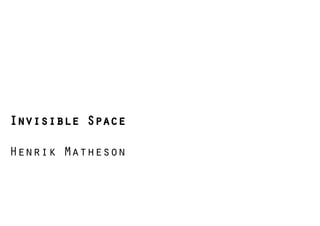
How an "invisible space
- 3. 25 years old, married. Originally from Fitjar and lives on Minde. Recently graduated as a social educator and is an active athlete. At the age of two she amputated her right leg from the middle thigh after a car accident. It also caused some minor damage to her lower right arm. She compeets in swimming where she holds seventeen world records.
- 4. For walking she uses an electric prosthetic leg. The prosthetic leg compensates for the physical strain and provides resistance when the knee is bent. In a walking motion the leg will automatically bend backwards when it is lifted from the ground. The limb contains an electronic processor and adjusts according to the users walking pattern.
- 5. She lives in a regular apartment on the third floor with no elevator. The apartment has no aiding equipment. Her sense of balance is well developed, so at home she takes off her prosthetic leg and jumps when she wants to move around. When asked what kind apartment she would prefer she answered that a compact one story solution placed on ground level would be more practical than the apartment she and her husband lives in now.
- 6. She has few limitations when it comes to tasks on a day to day basis, more of a like/dislike situation. Slippery surfaces and long stretches of hard surfaces can make it uncomfortable to walk. She is very aware of surface qualities and their physical character. Her preferred outdoor surface is a hard packed gravel, equal to a forest path or road. This kind of surface has a large amount of friction and is softer than asphalt. Indoors she prefers a material similar to wall to wall carpet. When bending down to pick up something she is solely dependent on her left leg and is therefore very reliant on a good surface adjusted to her need for stability and friction.
- 7. She introduced me to what is called the “GAP” model. It explains the relationship between the abilities and expectations in our society. ability to change handicap expectations abilities ability to improve A gap between these two defines a handicap.
- 8. I wanted the material to reduce her gap with the surroundings. I focused on qualities. Friction was a quality that concerned her and this quality seemed like a good start. It was something physical and I could use different samples to create a discussion.
- 10. Friction assembeled within a framework.
- 11. The focus could be on space, light or just the quality of the material.
- 12. element
- 13. I started working with carpets which is a high friction material build up by a system of threads.
- 14. The system of threads creates patterns in the carpet.
- 21. Threads put in a system creates the solid shape of the carpet. Without this system there is no carpet.
- 22. But if you take a thread or a string and apply energy to it, it also becomes something solid
- 23. and strong
- 24. And this can be even stronger if it is between two people.
- 25. Put in a system and influenced by interaction (applied energy) it can become somehing new.